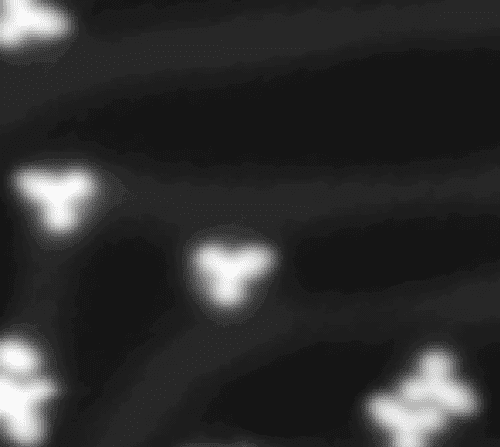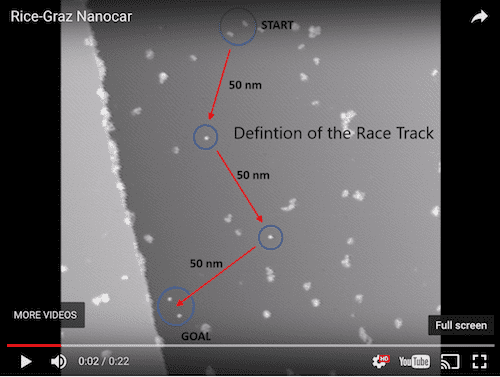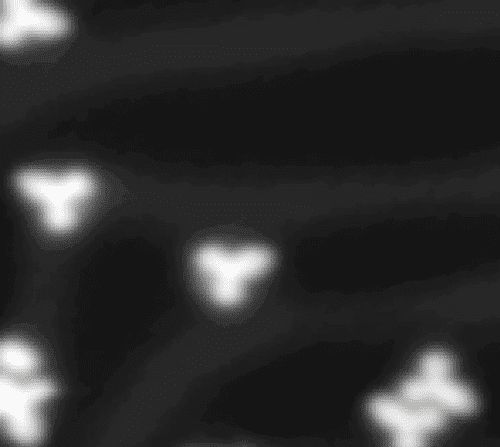
Our previous post announced a race around a 100 nm course of six NanoCars, each a unique concept created from only several dozen atoms and powered by electrical pulses. The race was run a few weeks later and two winners declared, due to two different tracks being used. From Swiss news “Swiss team wins shortest car race in the world“:
“Swiss Nano Dragster”, driven by scientists from Basel, has won the first international car race involving molecular machines. The race involved four nano cars zipping round a pure gold racetrack measuring 100 nanometres – or one ten-thousandth of a millimetre.
The two Swiss pilots, Rémy Pawlak and Tobias Meier from the Swiss Nanoscience Institute and the Department of Physics at the University of Basel, had to reach the chequered flag – negotiating two curves en route – within 38 hours.
The winning drivers, who actually shared first place with a US-Austrian team, were not sitting behind a steering wheel but in front of a computer. They used this to propel their single-molecule vehicle with a small electric shock from a scanning tunnelling microscope.
During such a race, a tunnelling current flows between the tip of the microscope and the molecule, with the size of the current depending on the distance between molecule and tip. If the current is high enough, the molecule starts to move and can be steered over the racetrack, a bit like a hovercraft.
[Includes 24-frame video from Basel University]
The race track was maintained at a very low temperature (-268 degrees Celsius) so that the molecules didn’t move without the current.
What’s more, any nudging of the molecule by the microscope tip would have led to disqualification.
Miniature motors
The race, held in Toulouse, France, and organised by the National Centre for Scientific Research (CNRS), was originally going to be held in October 2016, but problems with some cars resulted in a slight delay. In the end, organisers selected four of nine applicants since there were only four racetracks.
The cars measured between one and three nanometres – about 30,000 times smaller than a human hair. The Swiss Nano Dragster is, in technical language, a 4′-(4-Tolyl)-2,2′:6′,2”-terpyridine molecule.
The Swiss and US-Austrian teams outraced rivals from the US and Germany.
The race is not just a bit of fun for scientists. The researchers hope to gain insights into how molecules move.
Christian Joachim, head of research at CNRS, said that if they managed to control molecule movement, “we could create extremely miniature motors that could have all sorts of uses”.
Twenty years ago Dr. Joachim shared the 1997 Foresight Feynman Prize in Nanotechnology for Experimental Work with two researchers then at IBM Research Zurich for work using scanning probe microscopes to manipulate molecules. Eight years later he won the 2005 Foresight Feynman Prize in Nanotechnology for Theory for developing theoretical tools and establishing the principles for design of a wide variety of single molecule functional nanomachines.

Additional details and perspectives are provided by a Rice University news release written by Mike Williams. “Rice vehicle tops all in Nanocar Race“:
Rice University chemist James Tour [winner of the 2008 Foresight Institute Feynman Prize for Experimental work] and his international team have won the first Nanocar Race. With an asterisk.
The Rice and University of Graz team finished first in the inaugural Nanocar Race in Toulouse, France, April 28, completing a 150-nanometer course — a thousandth of the width of a human hair — in about 1½ hours. (The race was declared over after 30 hours.)
The team led by Tour and Graz physicist Leonhard Grill [winner of the 2011 Foresight Institute Feynman Prize for Experimental work] deployed a two-wheeled, single-molecule vehicle with adamantane tires on its home track in Graz, Austria, achieving an average speed of 95 nanometers per hour. Tour said the speed ranged from more than 300 to less than 1 nanometer per hour, depending upon the location along the course.
The Swiss Nano Dragster team finished next, five hours later. But organizers at the French National Center for Scientific Research declared them a co-winner of first place as they were tops among teams that raced on a gold track.
Because the scanning tunneling microscope track in Toulouse could only accommodate four cars, two of the six competing international teams — Ohio University and Rice-Graz — ran their vehicles on their home tracks (Ohio on gold) and operated them remotely from the Toulouse headquarters.
Five cars were driven across gold surfaces in a vacuum near absolute zero by electrons from the tips of microscopes in Toulouse and Ohio, but the Rice-Graz team got permission to use a silver track at Graz. “Gold was the surface of choice, so we tested it there, but it turns out it’s too fast,” Grill said. “It’s so fast, we can’t even image it.”
The team got permission from organizers in advance of the race to use the slower silver surface, but with an additional handicap. “We had to go 150 nanometers around two pylons instead of 100 nanometers since our car was so much faster,” Tour said.
Tour said the race directors used the Paris-Rouen auto race in 1894, considered by some to be the world’s first auto race, as precedent for their decision April 29. “I am told there will be two first prizes regardless of the time difference and handicap,” he said.
The Rice-Graz car, called the Dipolar Racer, was designed by Tour and former Rice graduate student Victor Garcia-Lopez and raced by the Graz team, which included postdoctoral researcher and pilot Grant Simpson and undergraduate and co-pilot Philipp Petermeier.
The purpose of the competition, according to organizers, was to push the science of how single molecules can be manipulated as they interact with surfaces.
“We chose our fastest wheels and our strongest dipole so that it could be pulled by the electric field more efficiently,” said Tour, whose lab has been designing nanocars since 1998. ‘We gave it two (side-by-side) wheels to minimize interaction with the surface and to lower the molecular weight.
“We built in every possible design parameter that we could to optimize speed,” he said.
While details of the Dipolar Racer remained a closely held secret until race time, Tour and Grill said they will be revealed in a forthcoming paper.
“This is the beginning of our ability to demonstrate nanoscale manipulation with control around obstacles and speed and will pave the way for much faster paces and eventually for carrying cargo and doing bottom-up assembly.
“It’s a great day for nanotechnology,” Tour said. “And a great day for Rice University and the University of Graz.”
Additional coverage:
In Science, by Robert F. Service “Watch the world’s smallest cars race along tracks thinner than a human hair“:
… To propel the molecular machines forward on their silver and gold tracks, researchers use electric jolts provided by the tip of a scanning tunneling microscope. After nearly 8 hours, the Austrian-U.S. entry, Dipolar Racer, has already crossed the finish line. The car, which resembles a molecular Segway without a handle, has completed two runs down its 150-nanometer silver track at an average speed of 35 nanometers per hour. At that pace, it would take hundreds of years to drive the car across a €1 coin. The Nano Dragster, entered by the Swiss team, was the first to complete a shorter, 100-nanometer-long gold race track. But the other four teams have struggled to even cross the starting line …
From National Public Radio, written by Merrit Kennedy “Microscopic Cars Square Off In Big Race” [includes 6:22 video]:
… The Austrian-U.S. team, driving the Dipolar Racer, finished hours before any of its competitors.
However, the two-wheeled car raced on its home track in Austria, on a silver track rather than a gold one. The team controlled it remotely. Rice University, where some of the scientists hail from, say silver was a handicap because it’s a slower surface. Race scientific director Christian Joachim tells The Two-Way that “they were unable to compete on gold because on gold the molecule was not stable enough.”
The next finisher, the Swiss Nano Dragster, was declared a co-winner – because it was the first team to finish on gold. …
From Chemistry World, written by Fernando Gomollón-Bel “World’s first nanocar race a success for science and engagement“:
…Steve Goldup, who works on interlocked molecules and molecular machines at the University of Southampton, UK, but didn’t take part in the race, says that the dipolar racer is a ‘really nice design’. He notes that the team ’optimised it to maximise the dipole (maximises the force created by the electric field of the STM tip) and minimise the molecular weight. It will be interesting to find out – and the experiments to work this out will be interesting in themselves – if the car skids along or if the wheels roll. Either way would achieve the goal as the wheels prevent the aromatic body from sticking to the surface.’ …
It is interesting that a small collection of molecular cars, all driven by electric pulses from an STM tip, differing substantially in design details, show such a wide range of performances. Perhaps this is not only an iconic event in the developing story of molecular machines, but a beginning of a systematic effort to understand function and engineer improved performance?
—James Lewis, PhD
Discuss these news stories on Foresight’s Facebook page or on our Facebook group.
